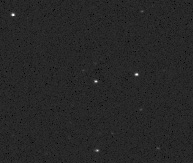
In this page you will find images of Near-Earth Objects (NEOs). North is up, east on the left. I hope people will find them useful for educational pourposes, as well as for their own work. If you are using them, I would love to hear from you. This page starts now to be regularly updated, after a 'silence' few years long.
In questa pagina si trovano alcune animazioni
relative ad oggetti Near-Earth (NEO). Il nord e' in alto e l'est sulla
sinistra. La speranza è quella di fare cosa gradita a chi si occupa di
divulgazione e a quanti hanno bisogno di simili riprese nel loro lavoro. Se
state utilizzando qualcuna di queste immagini, vi prego di segnalarmelo. Questa pagina riprende le pubblicazioni dopo una pausa di alcuni
anni.
Objects observed from Chile were imaged as part of
an educational project, in cooperation with Franco Mallia. To get them, we used the
SoTIE telescope (14"-f/7 + Paramount GT1100S + AP7) in Las Campanas and we are very grateful to the NASA/TIE
team (in particular Roger Wilcox for operating the scope while we observe),
as well as to Software Bisque, for their
support and disposability. We also thank Carnegie
Observatories and Las Campanas Observatory
for hosting the SoTIE telescope in Chile.
This page will be updated once new images will be available, check it regularly!. Those wishing to use them, are kindly asked to contact us. Last update: 12 Oct. 2004.
Questa pagina verrà aggiornata ogni qualvolta sarà disponibile nuovo materiale. Chi desidera utilizzare le immagini è gentilmente pregato di comunicarlo. Ultimo aggiornamento: 12 ottobre 2004.
Toutatis images and movies! Immagini e filmati di Toutatis!

|
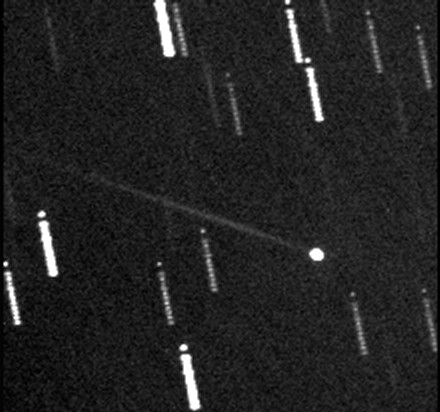
|

|

|
Upper Left: This object, P/2004 TU_12, was followed-up by G. Masi, f. Mallia and R. Wilcox at the discovery time and observed several nights, never showing something unusual (at the discovery time it received a typical asteroid designation). On Nov 12.0 UT, 2004 we spotted a nice tail, pointing at PA ~ 70 deg and 2' long. This discovery was immediately shared with the CBAT and MPC. Click on the image above to see a 2Mb movie showing the comet motion against the stars. N is up, east on the left. Observations were performed from Las Campanas, Chile (MPC code I05). Image above is the median of 103 CCD frames collected between 01:03 UT and 03:27 UT, 12 Nov 2004. The scale is 2x the original one. This finding was reported on the IAU Circular 8436.
Upper Right: Twelve, 60-seconds images were added, grabbed on Nov 14 2004between 04:37 and 04:56 UT. The tail is now longer than 5.8' and clearly faint. A disconnection seems to be visible just left of the nucleus. Log-scaling the image, the resulting brightness profile seems to confirm it. The scale is 2x the original one.
Bottom left: 57 images, each with an integration of 1-min, were divided in three sets (each with 19 images); images of each set were median combined (to remove star interference, for better analysis) and then the three resulting frames added. The images were collected on Nov. 15, between 00.47 and 02:05 UT. Again, the tail is quite faint close to the head.
Bottom right: 38 images, each taken using 60-sec of integration, where divided in two groups (with 19 images each); each group was used to create a new frame using a median combination (to limit star interference). The two median frames where then added. Images were taken on Nov 17, from 00:56 to 01:43 UT. Tail is even fainter than yesterday, also showing a change in the tail PA at about 3.3' from the head.
Sinistra in alto: Questo oggetto, P/2004 TU_12, è stato seguito sin dai tempi della scoperta da G, Masi, F. Mallia e R Wilcox e riosservato diverse volte, senza aver mai mostrato nulla di inusuale (all'epoca della scoperta, infatti, riceveva una designazione tipica da asteroide). Il 12.0 Nov. UT, 2004 abbiamo invece osservato la presenza di una coda lunga 2' e orientata verso PA ~ 70 gradi. La scoperta e' stata immediatamente comunicata al CBAT e all'MPC. Cliccare sull'immagine per vedere un'animazione di 2 Mb. N è in alto, E sulla sinistra. Le osservazioni sono state condotte da Las Campanas, Cile (codice MPC I05). L'immagine di sopra è il mediano di 103 riprese ottenute tra le ore 01:03 UT e le 03:27 UT del 12 Nov. 2004. La scala è 2x quella originale. Questo risultato è stato riportato sulla Circolare IAU 8436.
Destra in alto: Somma di 12 immagini, ciascuna da 60 sec, ottenute il 14 Nov 2004 tra le 04:37 e le 04:56 UT. La coda è adesso lunga più di 5.8' e decisamente più debole. Una disconnessione sembra essere visibile appena a sinistra del nucleo. Dopo uno scaling logaritmico, il profilo di luminosità sembra confermarlo. La scala è 2x quella originale.
Sinistra in basso: 57 immagini, ciascuna con integrazione di 1 minuto, sono state divise in tre gruppi (ciascuno con 19 frame); le immagini di ogni gruppo sono state combinate tramite mediano (per rimuovere le stelle) e i tre frame risultanti sono stati sommati. Le riprese sono state effettuate tra le 00.47 e le 02:05 UT del 15 Nov. 2004. La coda apparen ancora debole in prossimità del nucleo.
Destra in basso: 38 immagini, ciascuna integrata per 60 secondi, sono state divise in due gruppi, ciascuno con 19 frame; le immagini di ogni gruppo sono state combinate tramite mediano e le due risultatnti sommate. Le riprese sono state ottenute il 17 novembre, tra le 00:56 e le 01:43 UT. La coda èè più debole di ieri e mostra un cambiamento di angolo di posizione a circa 3.3' dalla testa.
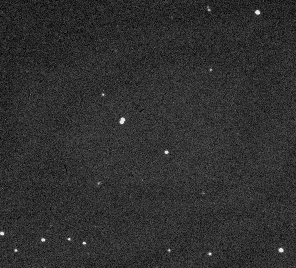
I did these images of 2004 TE10 from Las Campanas, Chile, remotely using the SoTIE (14"-f/7 + CCD) telescope, with the cooperation of Franco Mallia and Roger Wilcox. Images were grabbed between 02:48:56 and 02:53.03 UT, 9 oct. 2004. This object, accordingly with MPEC 2004-T31, passed at 0.0069 AU from the Earth; on the same circular, astrometry from the images above is visible (MPC code I05).
Queste immagini di 2004 TE10 sono state ottenute da Las Campanas, con il telescopio SoTIE (36cm-f/7), in collaborazione con Franco Mallia e Roger Wilcox. Le riprese sono state effettuate tra 02:48:56 e le 02:53.03 UT del 9 ottobre 2004. Questo oggetto, d'accordo con la circilare MPEC 2004-T31, è passato a 0.0069 UA dalla Terra; sulla stessa Circolare è pubblicata l'astrometria ottenuta dalle medesime immagini (codice MPC I05).
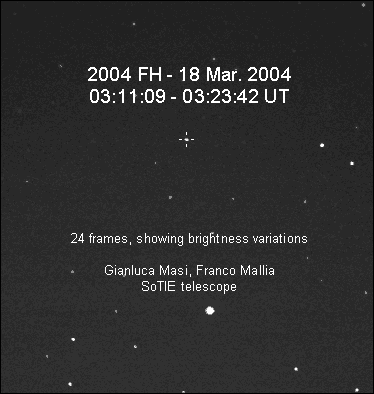
To see the animation, showing brightness variations, click on the image above. 2004 FH, on March 18.92 2004, reached a minimum distance of 0.00033 AU from our planet, making the second close approach ever recorded. The object was extensively observed from Ondrejov too, as part of the Ondrejov NEA Program. Quite fortunately, P. Kusnirak imaged it at the time (03:11:10 UT, 18 Mar 2004) it was observed from Chile. He kindly provided the images and I did a still image showing very well the parallax effect. The object was about 500000 km far away, while the observing stations where at about 12000km. The parallax angle was so huge that I needed to fill the gap using a DSS plate. Of course, the two CCD images were scaled and oriented to perfectly fit the DSS background. Parallax angle is more than 1 deg. The I05 code (upper left) indicates the SoTIE site (Chile) observation, while 557 (bottom right) the Ondrejov observatory one.
Per vedere l'animazione, che mostra le variazioni di luminosità, cliccare sull'immagine di sopra. 2004FH, il 18.92 marzo 2004, passò a sole 0.00033 UA dalla Terra, il secondo record di sempre quanto a passaggi ravvicinati.
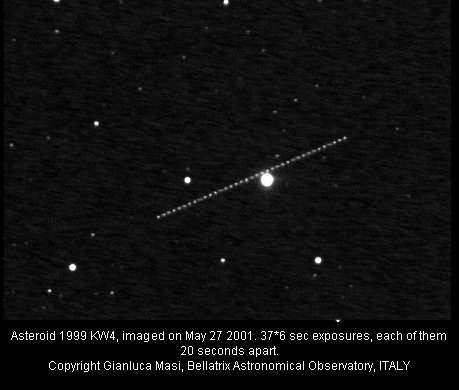
Click onthe image to see an animation from the same images.
Cliccare sull'immagine per vedere un'animazione realizzata dalle stesse immagini
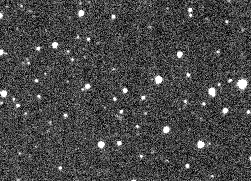
This image shows the NEO 1999 HX2, imaged on April the 25, 1999. The time interval between these two frames is of 17 minutes. MPEC 1999-H31
Questa immagine mostra il pianetino 1999
HX2, ripreso la notte del 25 aprile 1999. L'intervallo temporale tra le
immagini e' di 17 minuti. MPEC
1999-H31

This image shows the NEO 1999 LN28, imaged on July the 11, 1999. The time interval between these two frames is of 7 minutes. MPEC 1999-M04
Questa immagine mostra il pianetino 1999
LN28, ripreso la notte dell'11 luglio 1999. L'intervallo temporale tra
le immagini e' di 7 minuti. MPEC
1999-M04
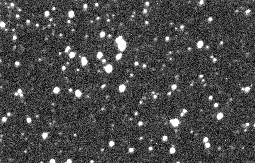
This image shows the NEO 1999 LO28, imaged on July the 10, 1999. The time interval between these two frames is of 5 minutes. MPEC 1999-M03
Questa immagine mostra il pianetino 1999 LO28, ripreso la notte del 10 luglio 1999. L'intervallo temporale tra le
immagini e' di 5 minuti. MPEC
1999-M03
Currently visible NEOs, for which observations
are requested, are listed at http://cfa-www.harvard.edu/iau/NEO/ToConfirm.html
Asteroidi Near Earth per i quali sono richieste
osservazioni sono riportati all'indirizzo http://cfa-www.harvard.edu/iau/NEO/ToConfirm.html
![]() Index
Eng
Index
Eng
![]() Indice
Ita
Indice
Ita